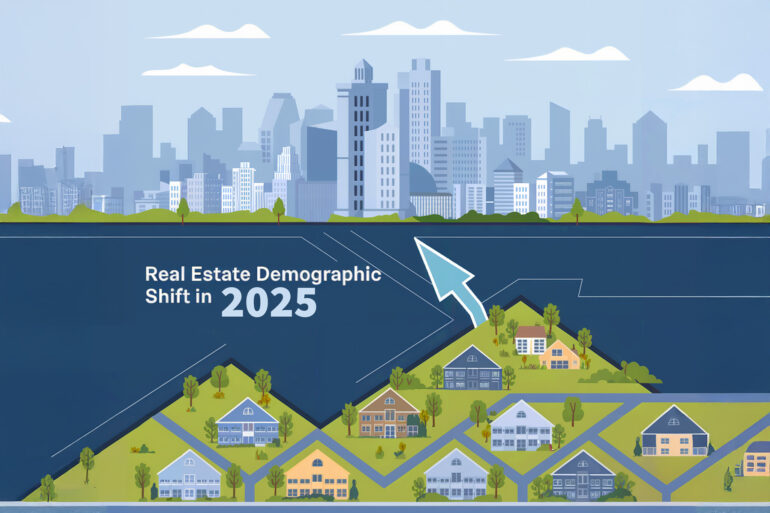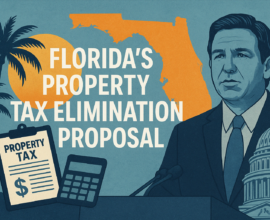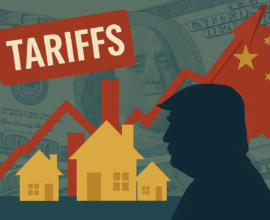From Urban Exodus to Suburban Surge: Real Estate Demographic Shift in 2025
The real estate landscape in the United States is undergoing significant transformation as we approach 2025. The COVID-19 pandemic has accelerated trends, leading to a notable shift from urban centers to suburban and even exurban areas. This movement, often called the “urban exodus,” reshapes housing markets, influences demographic patterns, and alters community infrastructures. Understanding the factors driving this migration is crucial for stakeholders across the real estate spectrum, from policymakers to investors and homebuyers.
According to a report by the National Association of Realtors (NAR), the shift toward suburban living is one of the most significant real estate trends in recent years. Additionally, research from the Pew Research Center highlights the role of COVID-19 in accelerating migration patterns, with remote work and quality-of-life priorities being key drivers.
The Urban Exodus: Why People Are Leaving Cities
Rising Cost of Living
Urban centers have traditionally been associated with higher living costs, but recent years have escalated these expenses further. The Consumer Price Index (CPI) for All Urban Consumers reported a 6.4% increase from January 2022 to January 2023, with shelter costs rising by 7.9% during the same period — the most significant 12-month advance since 1982 (U.S. Bureau of Labor Statistics).
This surge in housing expenses has made city living increasingly unaffordable for many residents. For instance, in 2024, San Jose, California, required an annual salary of approximately $265,926 to live comfortably, with San Francisco close behind at $252,878 (SmartAsset).
Work-From-Home Revolution
The COVID-19 pandemic has fundamentally changed work dynamics, with remote work becoming a permanent fixture for many companies. At the height of the pandemic, nearly 50% of Americans were working remotely; this figure has since stabilized in the mid-20% range, still significantly higher than the pre-pandemic level of 2-3% (Pew Research Center).
This shift has diminished employees’ need to reside near urban office locations, enabling them to seek more affordable and spacious living arrangements outside city centers.
Quality of Life Preferences
The desire for improved quality of life has also driven individuals away from urban areas. Factors such as the need for more living space, lower crime rates, and access to better educational facilities have made suburban and rural areas more attractive. Additionally, the rise in remote work has allowed families to prioritize these quality-of-life factors without the constraint of commuting to urban job centers.
A National Association of Realtors (NAR) study found that buyers increasingly value neighborhoods with parks, better schools, and larger homes over proximity to offices.
The Suburban Surge: Why the Suburbs Are Thriving
Affordability and Housing Inventory
Suburban areas often offer more affordable housing options compared to urban centers. In 2023, the cost of renting a home in the U.S. increased by 3.8%, the highest rate since 2011, with the median monthly rent reaching $1,406, according to Investopedia.
Despite rising costs, suburban homes typically provide more space and amenities for the price, attracting those seeking better value. According to a report by Redfin, homebuyers migrated from expensive urban markets, like San Francisco and New York, to more affordable suburban areas at record rates in 2023.
Growing Infrastructure in Suburbs
The expansion of infrastructure in suburban regions has further enhanced their appeal. Improvements in transportation, healthcare facilities, and educational institutions have made suburban living more convenient and desirable. For example, federal investments in public transit reached $13.6 billion in 2023, much of which was allocated to expanding suburban commuter networks (Federal Transit Administration).
These enhancements have allowed suburban areas to become better connected to urban job hubs, providing residents with the perfect balance of suburban tranquility and urban accessibility.
Family-Focused Living
Families have long favored suburbs due to larger housing options, safer environments, and quality schooling. The recent demographic shifts have reinforced this trend, with many families relocating to suburbs to access these benefits. According to the National Association of Realtors (NAR), 79% of suburban homebuyers cited family needs as a key factor driving their decision to move.
The availability of parks, recreational facilities, and community services tailored to family needs has further solidified the suburbs as the preferred choice for family living.
Demographic Drivers of Change
Millennials as First-Time Homebuyers
Now aged 27-42, millennials have emerged as a driving force in suburban homebuying. According to Freddie Mac, millennials accounted for 43% of homebuyers in 2023, with a significant proportion of these purchases occurring in suburban and exurban areas.
Many millennials delayed homeownership during the 2008 financial crisis and the pandemic but are now eager to settle down, driven by remote work flexibility and family planning. Suburban areas appeal to these buyers with their larger homes, outdoor amenities, and access to quality schools, accelerating the shift from urban living.
Aging Baby Boomers Downsizing
Baby boomers, aged 59-77, are also reshaping suburban markets. Many are selling large-family homes in urban areas to move into smaller, more manageable properties in suburbs or suburban-like retirement communities. A report by AARP highlights that over 50% of baby boomers prefer to age in place. Still, those who do move are drawn to suburban areas for their proximity to healthcare facilities, lower property taxes, and quieter communities.
This downsizing trend has created opportunities for younger families to buy larger homes vacated by baby boomers. It also underscores the importance of accessibility and amenities in suburban housing markets, making these areas increasingly competitive.
Emerging Trends to Watch in 2025
Hybrid Suburbs: The Rise of “15-Minute Cities”
Suburban areas are evolving into “hybrid suburbs,” where residents can access all essential services — work, schools, healthcare, shopping, and leisure — within a 15-minute radius. This urban planning concept, popularized in cities like Paris, is being adopted in suburban developments across the United States. The goal is to reduce reliance on long commutes while fostering a more connected and sustainable community.
Developments like Lake Nona in Florida and Daybreak in Utah exemplify this trend, blending residential spaces with business districts, parks, schools, and medical facilities. These “15-minute suburbs” are particularly attractive to millennials and Gen Z homebuyers who value convenience and sustainability. According to the Urban Land Institute(ULI), mixed-use suburban developments increased by 20% in 2023, which is expected to continue into 2025.
Tech and Real Estate Integration
Technology is reshaping how people choose, buy, and live in homes, with significant implications for suburban markets. PropTech (property technology) innovations like virtual tours, AI-driven home recommendations, and blockchain-based transactions make suburban homebuying more straightforward and more transparent. Companies like Zillow and Redfin report that over 60% of homebuyers in 2023 used virtual tools to explore properties, a figure expected to grow as these technologies become more accessible.
Smart homes and energy-efficient buildings are also becoming standard in new suburban developments. According to McKinsey & Company, energy-efficient homes now account for 35% of new builds in the U.S., driven by increasing consumer demand and stricter environmental regulations. Features like solar panels, smart thermostats, and EV charging stations are no longer luxury add-ons but are integral to modern suburban living.
As suburban areas adopt these innovations, they will continue to attract younger, tech-savvy buyers while meeting the growing demand for sustainable housing solutions. This technology and real estate convergence is poised to redefine suburban living in 2025 and beyond.
Challenges Facing Suburbs
Infrastructure Strain
The rapid population growth in suburban areas is straining local infrastructure, including roads, schools, healthcare facilities, and utilities. As families and individuals migrate from cities, suburban municipalities struggle to keep pace with demand. For example, the American Society of Civil Engineers (ASCE) report revealed that 44% of suburban roads are in poor or mediocre condition. In contrast, school districts in high-growth areas report overcrowded classrooms due to an influx of new residents.
Cities like Austin, Texas, and Charlotte, North Carolina, are grappling with challenges such as traffic congestion, insufficient public transit, and delays in infrastructure projects. These growing pains could hinder the long-term appeal of certain suburban areas if solutions are not implemented promptly.
Affordability Crisis Shifting to Suburbs
While suburbs have historically been a more affordable alternative to urban centers, this affordability advantage is shrinking as demand outpaces supply. According to ATTOM Data Solutions, the median home price in suburban areas increased by 10.3% year-over-year in 2023, compared to a 7.6% rise in urban markets. Rising interest rates and construction costs compound the issue, leaving many first-time buyers priced out of the suburban market.
The affordability crisis is particularly evident in suburban regions surrounding major metro areas like Seattle, Denver, and Miami, where inventory shortages drive fierce competition and bidding wars. Without affordable housing initiatives or zoning reforms, suburbs risk becoming inaccessible to the demographics driving their growth.
Balancing Development and Preservation
The suburban boom has reignited debates over land use, as developers push for new housing projects while residents advocate for preserving green spaces and maintaining the character of their communities. Large-scale developments often face resistance from local communities concerned about environmental impacts, loss of open spaces, and strain on existing resources.
For example, proposals for high-density housing in suburban California have sparked legal battles between developers and local governments trying to comply with the state’s housing mandates. According to the U.S. Green Building Council (USGBC), nearly 30% of suburban areas experienced significant disputes over land use policies in 2023.
Balancing growth with environmental preservation and community needs will be a critical challenge for suburban areas in 2025. Innovative planning solutions, such as incorporating sustainable design principles and engaging local stakeholders in decision-making, will be essential to address these competing priorities.
The Road Ahead: Navigating the Suburban Surge in 2025
The ongoing shift from urban to suburban living is profoundly reshaping the real estate market. As families, young professionals, and retirees continue to prioritize affordability, space, and quality of life, suburbs are experiencing unprecedented growth. This transformation is fueled by demographic drivers, like millennial homebuying and baby boomer downsizing, and emerging trends, such as hybrid suburbs and PropTech innovations.
However, this growth is not without its challenges. Strained infrastructure, rising home prices, and debates over land use threaten to undermine the long-term appeal of suburban living. Addressing these issues will require coordinated efforts from policymakers, developers, and local communities to ensure that the promise of suburban life remains attainable for all.
Looking ahead to 2025, real estate investors, agents, and homebuyers must adapt to these shifting dynamics. Those who understand the forces driving these changes will be best positioned to seize opportunities and navigate the evolving landscape. While urban centers may eventually recover and evolve, the suburban surge shows no signs of slowing, marking a pivotal moment in how and where Americans choose to live.
The future of real estate lies in striking a balance — leveraging growth opportunities in suburban markets while ensuring sustainability and accessibility for generations to come.








